Wild Wednesday: Aspen Valley Wildlife Sanctuary is rehabilitating five adorable moose calves
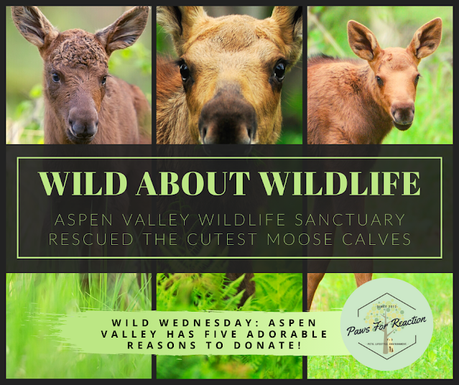
When I reached out to my fur-iends at Aspen Valley Wildlife Sanctuary and asked “Do you have any interesting animals in your care that I can feature for Wild About Wildlife Month?” their response was most amoosing!
“We currently have five moose calves on site.”
How can I resist five moose babies, with their gangly legs and too big heads and clippity-cloppity hooves? The answer: I can’t. I can NOT resist the opportunity to learn more about these moose calves. I mean, if I knew the story was going to be this adorable, I would have trimmed my antlers!
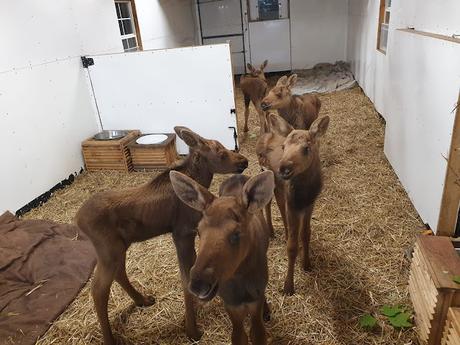
Photos via Aspen Valley Wildlife Sanctuary
As adorable as moose calves are, these animals are at Aspen Valley Wildlife Sanctuary because they need the help of its caring and experienced team. What makes Aspen Valley extra special is that it’s well equipped to offer a safe and healthy environment for large rescue animals. It's one of the many things that makes them unique and incredibly valuable to the community. The sanctuary rescues all animals, big and small, but their location offers 465 acres of beautiful Muskoka natural landscape in Rosseau, Ontario that can accommodate nature’s larger creatures. Aspen Valley is one of the only facilities in Ontario licensed to rehabilitate moose. The sanctuary is also one of the few wildlife rehabilitation facilities equipped with an aquatic facility to house and care for aquatic mammals year-round. They have big rescue energy.
These moose calves benefit big time from donations made by generous community members. I wasn’t surprised to learn that moose are very expensive to rehabilitate- and very challenging. Pet owners are familiar with the fun fact that the larger the animal, the more everything costs: food, medication, supplies. Large animals like moose also require more space- and Aspen Valley has FIVE of them. It’s a huge undertaking, literally and figuratively. This is what I like to call a ‘large act of kindness.’

I connected with Janalene Kingshott, Director of Animal Welfare at Aspen Valley Wildlife Sanctuary, to learn more about the adorable moose calves they have in their care. The first piece of important information I needed to know: What did they name the five moose calves? Jan did not disappoint!
“Murray, Moe, Maverick, and Mooney are males. Mayve is a female,” Jan said. “They were all born this spring.”
Aspen Valley already boasts a moose that is a permanent resident: Ella. She came to Aspen Valley in 2015 from another rehabilitation facility. She was an orphaned calf, and she broke her hind leg. Given the Aspen Valley team’s expertise in rehabilitating moose calves, it was decided Ella would receive the best level of care there.
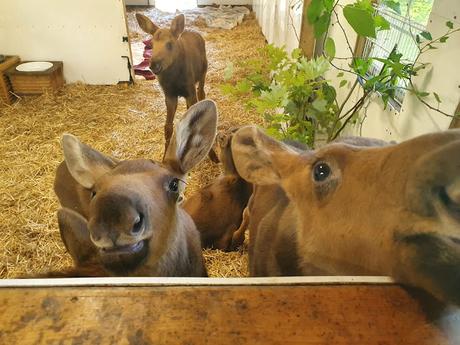
After multiple medical procedures and physical therapy Ella’s leg still didn’t heal well enough to allow her to be successful in the wild, and in July 2017 it was decided that she would officially become a permanent resident of the sanctuary. The most incredible part of Ella’s story is she became an essential part of Aspen Valley's moose-calf rehabilitation program. Ella acts as a surrogate mother for orphaned calves who require care. The number of humans who interact with calves is strictly limited to avoid habituation. In order to mimic the strong bond between cows and calves, caregivers sleep with calves until they can be placed with Ella.
“All calves bond to their caregivers,” Jan said. “We only have two staff experienced with moose calves that will take care of them. This year that is Paolina and Mon.”
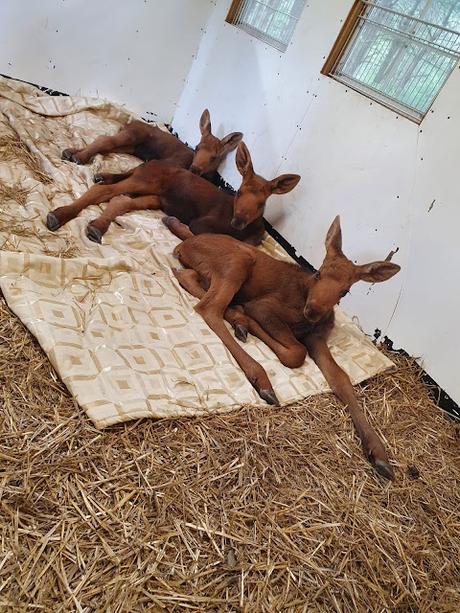
Orphaned moose calves stay in care at the sanctuary for about 18 months. This is the length of time that they would spend with their mother in the wild. This costs about $120.00 a week, per calf. For five calves, that’s an average cost of $600 a week. And something tells me this figure was calculated before the recently increased inflation. There's no moosing around when it comes to the care of these calves. I promoose that's my last moose pun. Maybe...
Jan explained that this care includes the calves' “food, housing, and medical care” along with the very specialized bonding that Paolina and Mon provide the animals. Medical care for these animals was critical from the very moment they were rescued. The calves ended up at Aspen Valley because of an unfortunate accident.
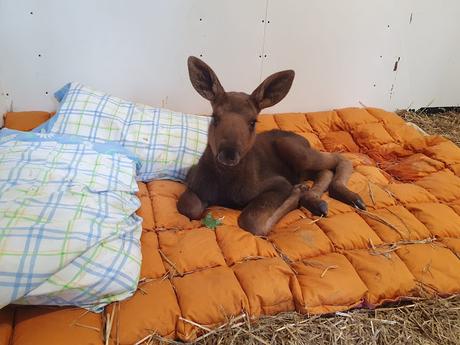
“Mayve was expelled from her mom when she was hit by a vehicle crossing the road,” said Jan. “Mom was killed instantly. Maverick was hit by a transport truck and injured. The other three were found alone. They had been alone for long periods of time, with no mom in sight.”
It’s a heartbreaking story that is all too familiar, especially as we continue to take over more and more green space that wildlife calls home, in the pursuit of economic growth. It’s important to remind ourselves- and our government- that we are encroaching on the animal’s habitat, not the other way around. The convenience a highway provides is not worth the long-term damage that declining biodiversity will cause. As grateful as I am that Aspen Valley is committed to rescuing and rehabilitating animals like the five moose calves, I wish we could prevent things like this from happening in the first place.
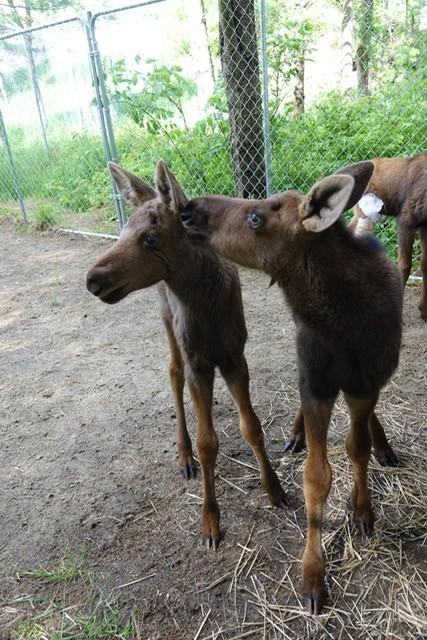
Protecting the moose population in the wild is important, especially here in Ontario. According to Aspen Valley “Over the past decade, the moose population in Ontario has dwindled by 20%. Several factors contribute to this. Hunting regulations allow 91,000 provincially licensed moose hunters for a population of only 78,000 moose. In addition, climate change and increasing temperatures in the Boreal Forest cause heat stress. Moose are adapted for extreme cold and deep snow, which allows them to avoid predation. Because winters are no longer cold enough and snow depth has decreased, moose can be hunted by their natural predators more easily.”
The goal of the sanctuary is to rewild animals- rescue, rehabilitate them, and release them back into the wild. In some cases, like with Ella, rewilding is not an option, and it is safer for the animals- even the big ones- to remain as permanent residents of Aspen Valley. That’s why it is so important they have sufficient space and community support via fundraising and donations. Luckily, Jan shared a positive prognosis for the calves, based on how well they are currently doing.
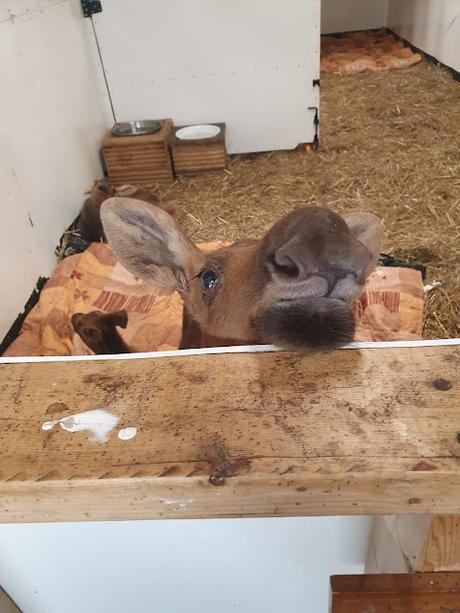
“The calves will be released at one year of age,” Jan said. “They are expected to be released in spring of 2023. We will be having a moose campaign soon to fundraise for the five calves. This will help with the cost of their food and shelter.”
You don’t need to wait for the moose campaign to help these adorable calves! You can donate to Aspen Valley Wildlife Sanctuary online by visiting their website. Please check out the many ways you can donate and support the wildlife in care at Aspen Valley Wildlife Sanctuary. You can even make a purchase at the Aspen Shop- all proceeds from sales go directly to the animals in their care!
Interested in following the rehabilitation story of Murray, Moe, Maverick, Mooney, and Mayve? You can track the moose calves' every move! Like the Aspen Valley Wildlife Sanctuary's Facebook page andInstagram, and check out theirYouTube channel.
Check out other Wild Wednesday posts!
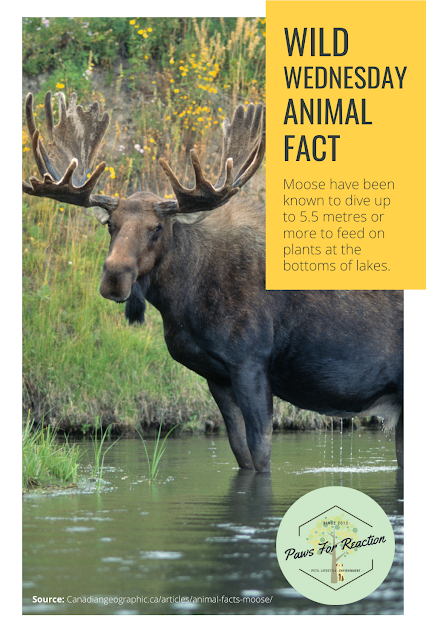
Like Paws for Reaction on Facebook
Follow @PawsForReaction on Twitter
Follow @PawsForReaction on Instagram
Follow my blog and subscribe in the sidebar >>
#WildWednesday

